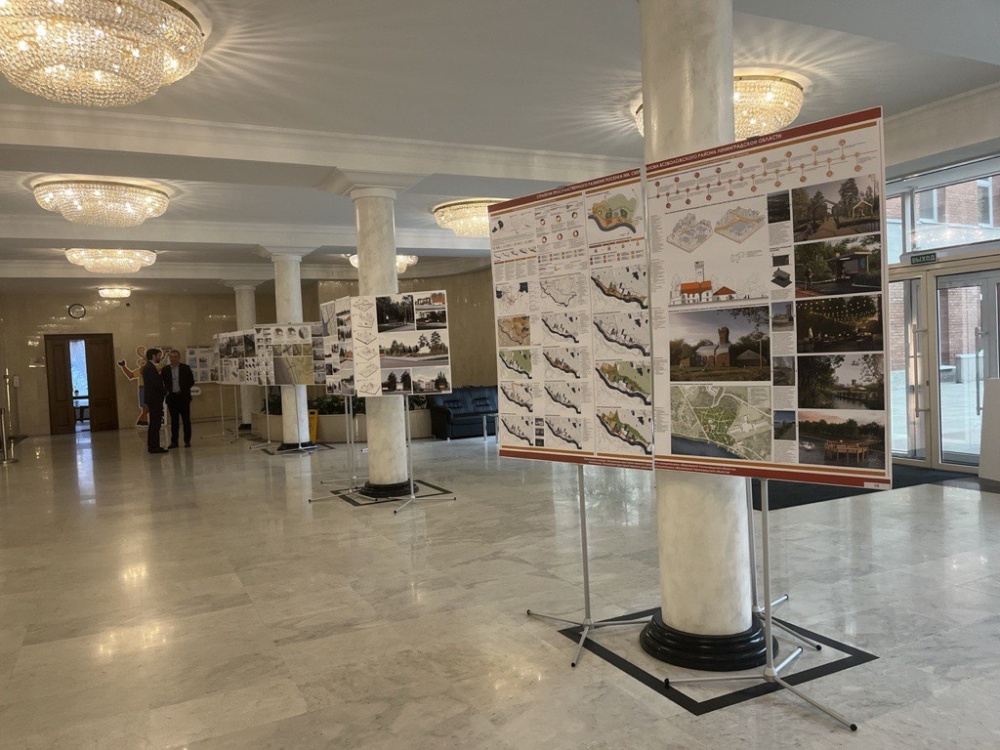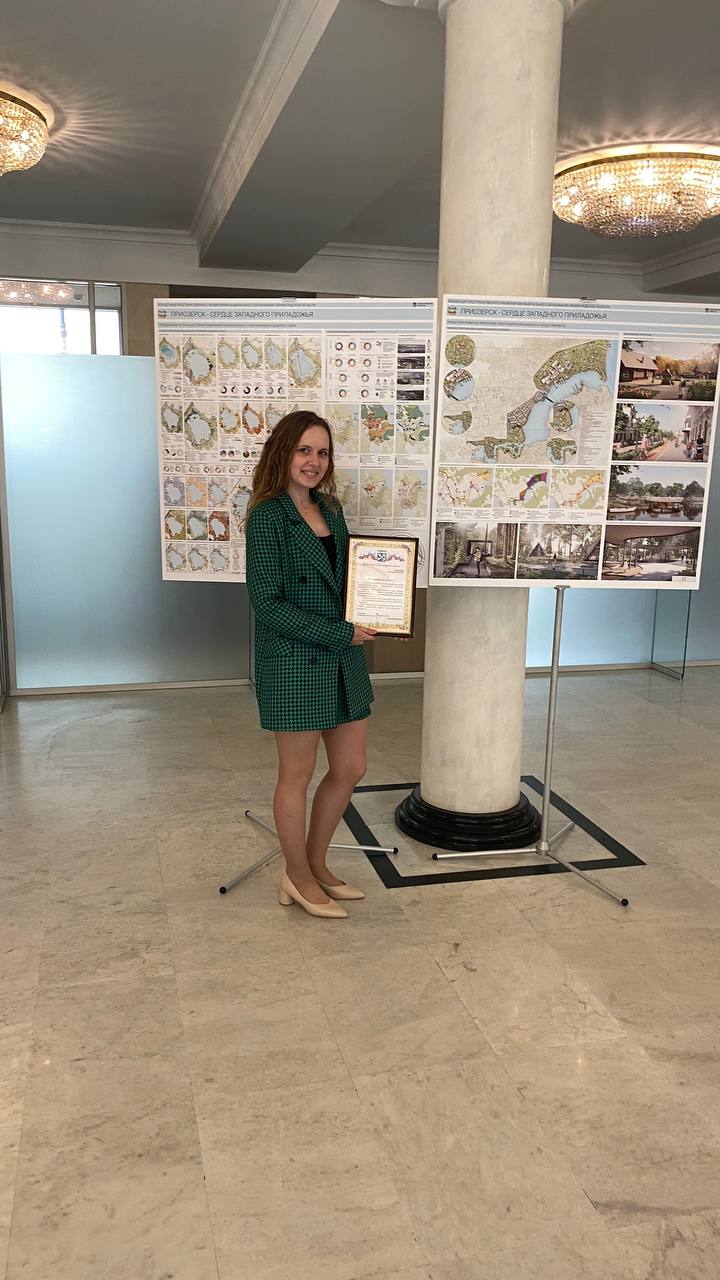 General view of the exhibition hall of the Government of the Leningrad Region
General view of the exhibition hall of the Government of the Leningrad Region
Second-year master's students of the SPbGASU Department of Urban Planning became winners and prize-winners of the competition "Concept of spatial development of municipalities of the Leningrad region." The competition, organized by the Urban Planning Policy Committee of the Leningrad Region since 2021, annually attracts architectural, urban planning and creative workshops, design studios and bureaus, representatives of scientific, pedagogical, and expert organizations. Participants' projects are judged in three categories. The ceremony of awarding and rewarding the winners took place on 20 May.
Contestants revealed the tourism potential of the Leningrad region
Governor of the Leningrad Region Aleksandr Drozdenko emphasized that many of the contestants’ works were aimed at developing domestic tourism and revealed the attractiveness of the region and its tourism potential. He stated the features of each settlement that “took part” in the competition, spoke about current problems of tourism infrastructure, and also named modern trends in the organization of tourism.
“All 23 participating projects are relevant and performed at a high level, and the implementation of some can begin now,” the governor noted.
Svetlana Levoshko, Associate Professor at the SPbGASU Department of Urban Planning, PhD of Architecture, curator of participants from this department, said that 32 first- and second-year master’s students of the Department of Urban Planning presented 10 projects in two categories: “The concept of spatial development of the municipal formation of the Leningrad region” and “The concept of comprehensive modernization of the memorial landscape complex "Road of Life".
“Some authors have participated in this competition for the second and third year in a row and have demonstrated their professional growth from the holder of a “certificate of participation” to the winner. These are Natalia Bazhanova, Viktoria Skoda, Irina Khaerova, Kristina Soloshchenko, Arina Pyattoeva. I am sure that the increased level of professionalism and accumulated experience in competitive design had its impact. The main thing is not to stop there,” noted Svetlana Levoshko.
How to create a tourism center in Priozersk
The project “Priozersk, the heart of the western Ladoga region” by Ekaterina Voronina was recognized as the winner in the first category. Svetlana Levoshko clarified that Priozersk is the theme of Ekaterina’s FQW, and this helped the author in developing competition tasks, and participation in the competition allowed her to strengthen certain aspects of the FQW. It’s sheer luck!
“The tourism potential of the Leningrad region and Karelia is great. However, the sharp increase in visitation to these regions showed that the infrastructure for such tourist flows is poorly developed. The situation leads to unorganized development of tourist sites, which negatively affects the ecological state of the territory, especially near the reservoirs of the Karelian Isthmus and Lake Ladoga. Therefore, in my work, I considered ways to form the Ladoga interregional zone with the creation of a large tourism support center in Priozersk,” explained Ekaterina.
The student clarified that this city was not chosen by chance: its history begins in the 13th century, its territories were an important part of the Western Ladoga region. However, due to the close location of the borders, the city was often destroyed, and practically no historical buildings survived.
“That is why, in the concept for the development of the embankment, I proposed forming a theme park with four zones reflecting different historical periods of the city: Novgorod Detinets (period of the Novgorod Republic), Swedish Detinets (period under Swedish rule), Russian city of the 19th century (period of the Russian Empire) and Industrial park (Soviet period),” said Ekaterina Voronina.
In addition, the author of the project proposes to create a central recreation park for local residents with various playgrounds, a sports school for sailing training, and new parking lots, including for tourist buses. There is also a new transport hub - a bus station with intercept parking and a pier from which you can go to any part of the Ladoga region.
“The entire project area of the theme park is connected by an embankment that starts from the Korela fortress and ends at the shore of Lake Ladoga. Routes are being improved to connect the new tourist area with existing sites of interest to tourists. This contributes to the formation of a unified complex in the city,” summed up the master’s student.
A settlement for comfortable living and recreation
Second place in the same category was taken by the project “Strategy for spatial development of the settlement named after Sverdlov, Vsevolozhsk district, Leningrad region” by a creative team consisting of David Kumalagov, Arthur Ramonov, Kazbek Tkhostov and Daria Chibirikova. The authors of the project believe that their development strategy will increase the attractiveness and competitiveness of the settlement as a place for comfortable living and recreation. The project provides for both targeted reconstruction and/or renovation of individual buildings and territories, and in general the creation of a high-quality environment for tourists and permanent residents of the settlement.
“The main objective of the strategy was the creation of a unified polycentric system of social and public infrastructure, which will ensure residents’ access to various social services and an increase in the quality of life. We paid great attention to the development of the Neva embankment. According to the concept, it should become the main longitudinal axis of the bicycle and pedestrian framework being formed and connect both individual public spaces and places of social activity within the settlement, and all coastal villages into a single tourist route. In addition, we propose to reclaim former clay quarries to eliminate their negative impact on the environment. Recreational, tourist and agricultural zones formed in these territories can become the main driver of economic growth of the settlement, attracting more investment and creating new jobs,” the authors said.
The master's students also proposed to improve the territory of the park of the Porogi estate and the section of the embankment closest to it, as well as to adapt the building of the former brick factory named after Pirogov for exhibition space. According to the authors of the project, in this way it will be possible not only to expand the functionality of the building, but also to preserve it as a historical heritage.
Revival of the former glory of the Road of Life
The project “Heart of the Road of Life” by the creative team consisting of Natalia Bazhanova, Anna Gorsheneva, Artur Ramonov and Viktoria Skoda was recognized as the best in the category “Concept for the comprehensive modernization of the memorial landscape complex ‘Road of Life’”.
“First of all, we sought to achieve visual integrity of design solutions and at the same time make them simple both in perception and in implementation. Wood and metal were chosen as the main materials, which make it possible to create both lightweight constructions and erect more permanent buildings and structures. In terms of design, we relied on architectural solutions characteristic of the village of Kobona and successful projects implemented in Karelia, while saturating them with visual images associated with the Road of Life,” said Natalia Bazhanova.
In the same category, second place was awarded to the project “Road of Life” by a creative group consisting of Ekaterina Voronina, Irina Khaerova, Arina Pyattoeva, Kristina Soloshchenko and Roman Malay. As the authors of the project said, during the siege of Leningrad, the village of Kobona was the most important point in the city’s supply system and the evacuation of residents along the Road of Life, and currently this settlement needs to be restored to its former glory.
“We looked at four main spaces in the village of Kobona: this is the existing tourist center near the Road of Life Museum, the area near the monument to the legendary semi-truck and the embankment of the Kobona River, as well as a recreational space near Lake Ladoga. The space has been adapted into a military theme park, where military objects are integrated into the display elements, be it multimedia spaces on rails in former carriages or recreated trenches formed using geoplastics. The appearance of the tourist center echoes the characteristic buildings of Kobona and the images of road houses of the 18th century. The design of small architectural forms uses the identity of the territory: a cross element, a spontaneously appeared arch, which over the years has become a recognizable symbol of the village. Lighting options have been proposed for existing monuments to the Road of Life, which will emphasize the uniqueness of each of them,” said Irina Khaerova.
Participation in a competition is a strong motivation
The competition has become significant not only for the winners and prize-winners, but also for all participants. Thus, the team of authors consisting of Anastasia Mishalueva, Regina Polishchuk and Maria Kolobova with their project “The Concept of Strategic Development of the Otradnenskoye Village, Pella Embankment” was included in the shortlist and was presented at an exhibition in the building of the Government of the Leningrad Region. The same recognition was given to the project of the team of authors consisting of Anastasia Kaledina, Anna Baranova and Andrey Zima on the topic “Concepts of spatial development of the village named after Morozov, master plan and design proposal for the Neva embankment".
Anastasia Mishalueva admits that as a result of participating in the competition, she changed her attitude towards such events. “Our project did not win, but was among the best, and this is a significant achievement for each of the participants. Despite the heavy workload, our team completed the project, which was noted by the chief architect of the Leningrad region. As part of the competition, we visited the Government of the Leningrad Region building, which further motivates us to participate in such competitions,” she said.
Svetlana Levoshko and Associate Professor at the SPbGASU Department of Urban Planning, PhD of Architecture Oksana Peslyak were presented with letters of gratitude from the governor for their contribution to the development of municipalities of the Leningrad region in the field of urban planning.
In addition to SPbGASU, students from the St Petersburg Academy of Arts, St Petersburg Mining University, St Petersburg Polytechnic University and St Petersburg State Forestry University took part in the competition.











